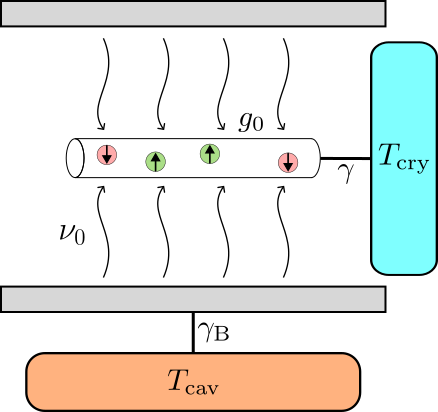Md Mursalin Islam

Research
My research concerns non-equilibrium phenomena in quantum many-body systems. It ranges from studies of the dynamics of quantum systems starting from non-thermal initial states to controlling material properties via cavity-induced non-equilibrium steady states. I use Schwinger-Keldysh (non-equilibrium) field theory as my primary tool of investigation along with numerical methods.
Cavity-control of quantum-materials

Cavity-quantum-materials have emerged as a platform to study non-thermal many-body physics. Putting the electronic system inside the cavity mirrors provides us with the noninavsive control of the collective electron behavior. We show that in such a setting the electrons can reach a steady state where the thermal-symmetry of the distribution function is broken. Further, the nature of the non-equilibrium steady state can be controlled just by changing the fundamental cavity frequency which is inversely proportinal to the distance between the cavity mirrors.
In a system showing a spontaneous phase transition, the cavity can influence the nature of the transition immensely due to the non-thermal nature of the distribution function. In this context, the non-thermal enhancement of the superconducting (SC) gap, known as 'Eliashberg effect' has been studied previously. We extended the analysis to the case of charge-density-wave (CDW). We show that while the order parameters for SC and CDW obey the same gap-equation at thermal equilibrium, out-of-equilibrium (i.e. coupled to the cavity) they differ. For the SC case, we observe a shift from continuous to first-order phase transition. In contrast, the CDW case, the phase diagram contains more features. Depending on the cavity frequency, both continuous and discontinuous transitions are possible. We also observe two distinct ordered phases, and a bistable region ending at a critical point.
Relevent publications:
- arXiv:2509.07865: Cavity-induced Eliashberg effect: superconductivity vs charge density wave, Md Mursalin Islam, Michele Pini, R. Flores-Calderón and Francesco Piazza
- Phys. Rev. Research 7, 013073 (2025): Nonthermal electron-photon steady states in open cavity quantum materials, R. Flores-Calderón, Md Mursalin Islam, Michele Pini and Francesco Piazza
Dynamics of bosons from non-thermal initial states
Describing the dynamics of quantum many-body systems starting from non-thermal initial states is a daunting task. We developed a field-theoretic method to describe dynamics of scalar fields (which is used to describe bosonic excitations e.g. phonons, magnons, photons etc.) from non-thermal Fock states.
We used this method to study open-system dynamics of phonons coupled to thermal baths. We found that low-momenta photons coupled to a bath of fermions in 1D fail to thermalize. At low temperatures, strict phase-space constrains prevent the phonons to see the bath. On the other hand at high temperatures, formation of an undamped mode due to the diverging densityof states in the bath prevents thermalization.
Further, we looked into the dynamics of a closed interacting system of bosons with dipole-moment conservation in addition to charge conservation. At thermal equilibrium, we found two
kind of phases: a condensed phase where both charge and dipole-moment are not consereved and a localized normal phase where both the charge and dipole-moment are conserved. We show that via non-equilibrium dynamics (e.g. quench, ramp) we can access an additional phase where charge is conserved but dipole-moment is not.
Relevent publications:
- Phys. Rev. B 108, 214314 (2023): Non-equilibrium dynamics of bosons with dipole symmetry: Large N Keldysh approach, Md Mursalin Islam, K. Sengupta and Rajdeep Sensarma
- Phys. Rev. B 106, 024306 (2022): Nonequilibrium scalar field dynamics starting from Fock states: Absence of thermalization in one-dimensional phonons coupled to fermions, Md Mursalin Islam and Rajdeep Sensarma
Teaching
I worked as a teaching assistant of the following courses:
- Exercises in theoretical physics for secondary school teacher candidates (Winter sem. 2025-26) at University of Augsburg [Instructor: Dr. Marcus Kollar]
- Quantum Mechanics II (Spring sem. 2020) at TIFR, Mumbai [Instructor: Prof. Nilmani Mathur]
- Statistical Physics I (Spring sem. 2019) at TIFR, Mumbai [Instructor: Prof. Kedar Damle]
- Quantum Mechanics II (Spring sem. 2018) at TIFR, Mumbai [Instructor: Prof. Vikram Tripathi]